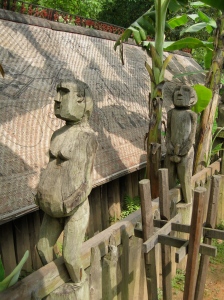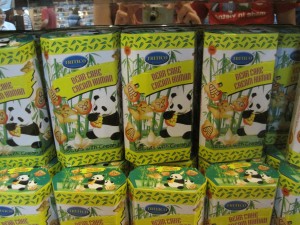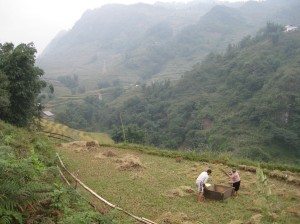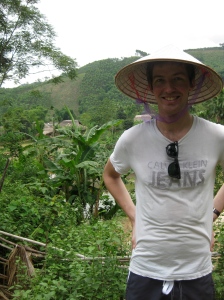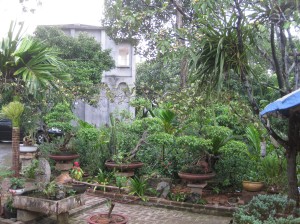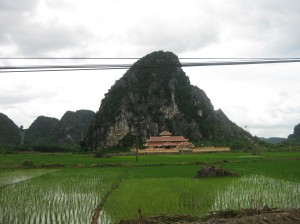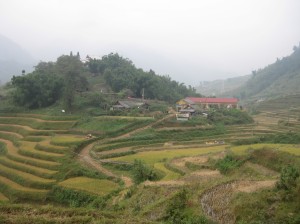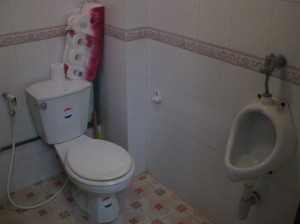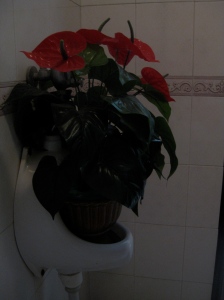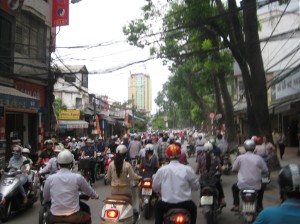At the end of my seven-month stint as a volunteer living and working in Hanoi, I feel it’s fitting to pass on some of the “wisdom” (charitably defined) I have accumulated over my time here. As such, in my final post to Good Evening Vietnam, I’d like to present five lessons for living in Hanoi that you won’t find in any guidebook. I emphasise ‘living’ because I’m not suggesting that anyone who visits the city for only a few days should necessarily start following these prescripts: you’d probably get yourself killed. But if you’re due to bed down here for a month or more you’re unlikely to go wrong by following these simple instructions.*
*Of course the author holds no legal liability if you should “go wrong” by following these simple instructions.
1. ‘Boil it, peel it, cook it’ … forget about it!

The risk of a mild case of gastro is a small price to pay for the privilege of tasting Bun Dau Mam Tom (rice noodles and tofu dipped in stinky fermented shrimp paste)
During my first week in Hanoi my fellow volunteers and I were ushered into a medical clinic for a briefing on common Hanoian health issues. The stern GP cautioned us to avoid motorbikes, mosquitos, late-night ‘romantic’ encounters and street food. From what I could tell, anyone who followed his advice would live out a hermetically-sealed existence spent darting between homes festooned with mosquito netting, air-conditioned taxis, and over-priced expat restaurants. What fun!
If you’d prefer to live a little more on the edge and don’t mind referring every so often to your “Self-management of Traveller’s Diarrhoea” ‘flow’-chart (See Appendix, possibly literally), then I advise that you throw caution to the wind, sit yourself down on a miniature stool by a street food vendor from time to time and dig in. I’ve always thought that you’re on safer ground anyway, buying something like street-side nom ga (salad with chicken) from a motherly-looking lady who is exclusively making nom ga (salad with chicken) than to venture into a familiar-seeming ‘restaurant’ that has a voluminous English menu, few customers and an unseen kitchen.
Sure, the nom ga lady has whole, uncooked chickens flapping in the breeze for all to see but, given her turnover, those chickens were probably running around on the street a few minutes ago, whereas we can only speculate how the cafe is hygienically storing all the ingredients necessary for dishes ranging from fresh spring rolls to spaghetti bolognaise. My advice: stick to the street.
2. Jump on your bike and plug in your headphones.
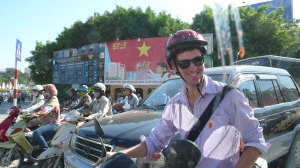
Displaying all the latest trends in Hanoian traffic-wear, Mike is seen here sporting a jauntily cocked 'Protec' helmet ($10), authentic, grit-and-bug-beating 'Ray Ban Wayfarers' ($5), and his ubiquitous, noise-cancelling, in-ear headphones. Looking good Mike!
Unless you’re planning on braving Hanoi’s regularly terrifying taxis on a daily basis or investing in one of its curiously proliferating Mercedes, BMWs or Bentleys, it’s likely that you’ll often find yourself wending your way through its chaotic streets on the back of a bike (whether of the motor or pedal-powered persuasion). In order to maintain your sanity amidst the exhaust fumes, beeping, and occasional flirtations with death (for a fuller depiction, see this post), I’d suggest defying common sense and simply plugging in your iPod as a form of mild escapism.
Some naysayers will suggest that riding a bike in Hanoi requires undivided attention and full use of one’s aural capacities, but to them I say, “fooey”. What minor degree of spacial awareness and concentration you lose is more than compensated for by the sense of calm you’ll attain, powering through the traffic to the tune of Belle & Sebastian’s ‘Loneliness of a Middle Distance Runner’, Outkast’s ‘Hey Ya’, or perhaps the Economist magazine’s audio editions. And apart from your Zen state of relative tranquility, your ears will thank you for shielding them from the deafening tumult of inconsequential beeping and honking outside of your immediate, three-metre hazard radius.
3. Ignore the ‘Sights’.
Ok, perhaps I’m overstating my case in the title here but I genuinely think that Hanoi’s greatest charms lie more in its everyday, unexpected curiosities than in its historical and cultural ‘attractions’. If you spend your free weekends working your way methodically through every museum and pagoda on Lonely Planet’s ‘Must See’ list then I think you’re missing out on something smaller and yet more wonderful. Don’t get me wrong, there are some worthwhile tourist destinations in Hanoi: in particular the Museum of Ethnography with its impressive collection of hilarious, erotic, wooden statuary.
But I went seven months in Hanoi without feeling a pressing desire to visit Ho Chi Minh’s Mausoleum (all due respect to the guy, but he wanted to be cremated anyway), the History Museum (and I’m a history buff), or any number of ‘significant’ pagodas, and I don’t feel like I missed all that much. What I would suggest instead is to immerse yourself in Hanoi’s hurly-burly daily rhythms and focus on its simple delights, like getting a $3 hair cut and ear polish or people-watching over beer and hotpot at your local bia hoi. And keep your eyes peeled for Hanoi’s hidden gems, such as comically butchered English language product descriptions:
I think I found more joy and excitement from encountering ‘Benign Girl’ in a street-side toy store than I experienced during my entire visit to the Temple of Literature. You probably would too.
4. Get out of town.
One of the many little ‘pearls of wisdom’ that I occasionally dream up and then repeat ad nauseum to anyone who’ll listen is that “the best way to enjoy Hanoi is to get out of it”. Although I just like the sound and moderate cleverness of this phrase, I also think that it is probably true. Despite the various official and unofficial pleasures of living in Hanoi that I have described above, it is certainly the case that the city can get on top of you at times. The beeping, the pollution, the karaoke, the heat, the cold, the bustling masses: it makes you yearn for peace and quiet and most of all, space. My advice to you then is to make time to head for the hills (or coast) every so often and seek out these precious commodities. Here are a few suggestions for weekends or day trips within spitting distance (200kms) of Hanoi:
Ba Vi National Park
Yen Bai Province
Tam Coc
Sapa
Halong Bay
5. Wear pink shorts.
In my first ever post to Good Evening Vietnam, written during my second week in Hanoi, I told the story of my introduction to the reluctant Hanoian fashion scene of short, pink shorts. At the time I lamented my cultural and stylistic insensitivity for ever considering that such a garment would fit in to a society where all men wear jeans (or long pants of some description), even in 40 degree heat and 100% humidity. What I have come to learn over the past seven months is that, regardless of what I wear, I’m never going to fully ‘fit in’ to Vietnamese society, and so I might as well flaunt my pink shorts for all to see. I’m likely to get strange, occasionally scandalised looks of course, but I won’t look quite so foolish as the strange character in the photo below, who appears to be kitted out entirely in quick drying, moisture wicking, mosquito repelling, wonder clothes that make him look like a complete idiot.

Clutching his Lonely Planet Guide firmly, safe in the knowledge that his shoes are 100% waterproof and breathable, this intrepid explorer sets off on a leisurely cruise up the Red River into deepest darkest tourist country.
When times got tough, when language barriers and technological difficulties and hygiene deficiencies threatened to overwhelm me, I would sometimes strip off my stinky jeans and slip on my pink (happy) shorts and everything would suddenly feel alright.
Appendix:
Diarrhoea ‘Flow’ Chart


